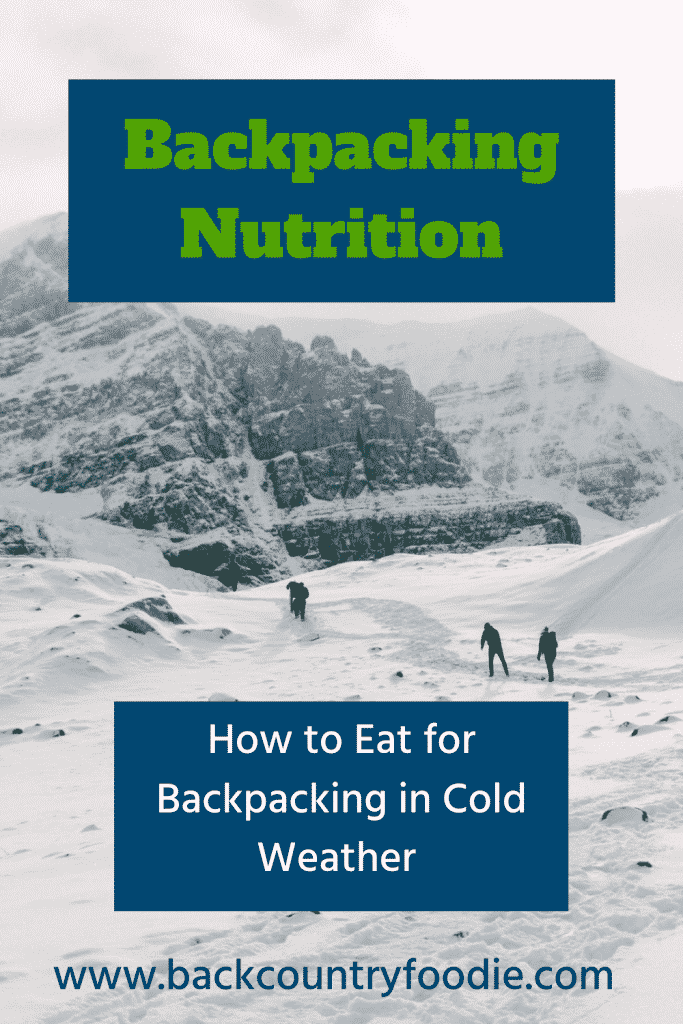How to Eat for Backpacking in Extreme Conditions
By Jill Kott & Aaron Owens Mayhew, MS, RDN, CD
Updated January 14, 2024
This post may contain affiliate links.

How do extreme conditions and altitude affect backpacking nutrition needs?
Whether it’s the harsh desert sun or a frigid gust of wind, if you’re a backpacker, it’s likely that you’ve braved the elements once or twice. But what effect do these extreme conditions have on our bodies? Depending on the season and location of your next trip, you may need to pay special attention to your backpacking meal plan to stay well-fueled.
Backpacking in Cold Climates
Cold Climate Calorie Needs
If you’re used to hiking in temperate climates, you may be surprised to learn that your calorie needs will increase when backpacking in colder climates. Shivering alone can burn up to 400 calories in one hour. If you’re outside shivering for multiple hours a day, that is a lot of calories burned! In addition, cold-weather clothing can weigh up to 5 lbs for a day hike or 15-20 lbs for an Arctic expedition. Wind speed and trekking conditions, such as snow and ice, can increase energy expenditure, increasing your calorie needs. Whether you’re post-holing your way through deep snow or kicking steps to scale a snowy mountainside, you’re likely working harder in these extreme conditions than in a temperate climate.
Pro Tip: Consistent Eating Times
- Eat every 60-90 minutes
- Consume carbs with every meal and snack
Why?
Glycogen stores, also known as your body’s carbohydrate stores, can be depleted within 1-3 hours, depending on how hard you work. If your glycogen stores become depleted, your body will break down your muscles to create fuel. Eating frequently can prevent your glycogen stores from being used up quickly. Consuming carbs with every meal and snack will keep fuel in the tank and protect against muscle breakdown.
Nutrition at High Altitude
Your body also requires more carbohydrates at high altitudes. The hormones adrenaline, noradrenaline, and cortisol are all elevated with exercise at altitude. These hormones increase the use of carbohydrates for fuel. Researchers recommend that athletes backpacking at altitude consume at least 60% of their daily calorie intake from carbohydrates.
For example, if you need 5000 calories in a day:
- 5000 calories * 60% = 3000 calories = 750 g carbs
- Typically ~20 carbs per snack bar, ~50-60 g carbs per one of our entree recipes
- If you eat 3 meals:
- 50-60 g X 3 meals = 150-180 g carbs
- That leaves 570-600 g of carbs to be eaten in snacks! (that’s a lot of snack bars!)

Be Prepared for Emergencies
It is also helpful to keep emergency food on hand if you find yourself in a situation where you require more than you planned. When trekking in wintery conditions, it is possible that your trip will take longer than expected. Navigating snowy and icy terrain often takes longer than hiking a dry, dirt path. Having emergency food on hand is a smart way to prevent hunger if you are on the trail longer than expected.

Cold Climate Hydration Needs
Even though you may not feel like you’re dripping in sweat, hydration needs do increase during cold climate backpacking. Water is lost through your respiratory system due to low humidity and an increased breathing rate as you work hard to scale the wintery terrain. It is possible to sweat up to 1 liter (32 oz) of fluid per hour due to the warm, humid environment that is created under your winter clothing. There are a variety of barriers to drinking fluids that can lead a backpacker to become dehydrated in cold climates, such as water bottles freezing at night when temperatures drop.
Pro Tip: Sleep with your water bottle/water bladder in your sleeping bag at night to prevent the water from freezing.
It can also be tedious to constantly remove your gloves and dig in your backpack for your water under extreme conditions. One strategy for staying on a consistent hydration schedule without taking your gear off, again and again, is to hydrate hourly. Aim for 0.5 liter (16 oz) to 1 liter (32 oz) per hour to stay adequately hydrated. For reference, a 32 oz. Nalgene bottle is about a liter, which is between ½ to 1 full Nalgene bottle per hour.
Have you struggled to keep your food from freezing in cold weather conditions?
Consider watching this video for hiking foods that work best in cold climates.
Backpacking in Hot Climates
Heat Acclimatization
Heat acclimatization refers to physical adaptations that occur after prolonged exposure to a hot natural environment. These bodily adaptations reduce strain on the body and allow for improved endurance in hot climates. This process can take anywhere between 5 to 14 days. By allowing the body to adjust to the hotter climate before beginning strenuous activity, you also reduce your risk of serious heat-related health complications like heat stroke. If possible, try taking a few days to adjust to the heat if you travel to a much hot climate than your home. This is a simple yet effective way to make backpacking in extreme conditions a little bit easier.
Pro Tip: Arrive at your hot climate destination a few days before heading out on the trails to give your body time to acclimate.
Hot Climate Calorie Needs
Calorie requirements for backpacking in hot climates are increased due to increased cardiovascular function as the body works to dissipate heat and increase sweat gland activity. It is estimated that energy needs can increase between 0.5-18% at temperatures between 86°F (30°C) and 104°F (40°C). Energy requirements for exercise in hot climates vary depending on heat acclimatization. The more acclimatized you are to the heat, the less your energy needs increase.
Pro Tip: Eat Even When Not Hungry
- Intense heat can sometimes reduce appetite
- Eat at consistent intervals (even though you may not feel as hungry as you usually do)
- Aim to eat a snack every 60-90 minutes
- Consider meal replacement drinks if your appetite is non-existent
Interested in learning how to estimate your nutrition needs for your next backpacking trip? Check out this post!

Hot Climate Hydration Needs
It is important to stay properly hydrated when backpacking in the heat. Excessive dehydration can decrease exercise performance and increase the risk of heat illness. Heat illness is an umbrella term that includes heat rash, cramps, heat exhaustion, and heatstroke.
The following are signs and symptoms of dehydration:
- Thirst
- Unusual fatigue
- Lightheadedness
- Headache
- Dark urine
- Dry mouth
- Infrequent urination
- Rapid heartbeat
Pro Tip: Hydrate Before Hitting the Trails. Drink 2-3 cups (480-720 mL) of fluid 4 hours before starting the activity.
How much should I drink on the trails?
- Aim to drink about 0.5-1.0 liter per hour while on the trails.
Want to be more precise with your hydration?
An accurate way to measure your hydration needs is by weighing yourself before and after a day hike to see how much water weight was lost. Make sure to weigh yourself naked to get the most accurate results possible. Replenish with 24 oz (750 mL) of fluid for each lb lost. You can use this as a reference in the future when you need to hydrate but don’t have the ability to check your weight.
Is it possible to overhydrate?
It is also possible to over-hydrate, which can cause electrolyte levels to drop too low. When sodium levels in the blood drop below 130 mmol/L, this is called hyponatremia. Hyponatremia is very serious as it can cause seizures, kidney damage, coma, and potentially death. If you notice that you weigh more after a day hike, you likely drank too much water and should cut back next time.
The following are signs of hyponatremia:
- Bloated stomach
- Puffy fingers and ankles
- Bad headache
- Confusion
Have you struggled to stay hydrated while backpacking?
Consider watching this video to learn about hydration in the backcountry.
Planning Ahead is Key
Making sure that you have enough food and water on the trail is not only good for your health, but it will also make your hiking experience more enjoyable. Headaches, fatigue, and hunger can all damper your hiking experience, but they can be prevented with a solid backpacking meal plan. Ensuring you are well-fed and adequately hydrated will make your time in the backcountry much more special.
Backcountry Foodie is your go-to resource for over 200 backpacking dietitian-created recipes, a one-of-a-kind automated meal planning tool, virtual masterclasses, YouTube videos, and podcast episodes.

Pin it and share it with your fellow backpackers!

Ready to learn more about eating for backpacking in extreme conditions?
Check out these posts:
- What to Eat and Drink While Hiking in Hot Weather
- Backpacking Nutrition: Tips for Recovery on the Trail
- Top 6 Nutrition and Hydration Tips for High Altitude
- A Look at Supplements, Meals, and Snacks for Muscle Recovery
ABOUT THE AUTHORS:
Jill Kott was a nutrition intern mentored by Aaron Owens Mayhew, MS, RDN, CD, and completed her Dietetic Internship at Seattle Pacific University to pursue a career as a Registered Dietitian. She has previously embarked on a week-long backpacking trip through the Sequoia National Forest and loves to take advantage of all of the scenic trails located near the Seattle area.
Aaron Owens Mayhew, MS, RDN, CD, is a registered dietitian and ultralight long-distance backpacker with over 20 years of nutrition and backpacking experience. She’s also the founder and owner of Backcountry Foodie, an online ultralight recipes and meal planning platform for backpackers. She also enjoys teaching hikers about backpacking nutrition via virtual masterclasses, YouTube videos, and podcast episodes. You can follow Aaron’s adventures in the kitchen and the backcountry via Instagram and Facebook.
Sources:
- Bailey, S. P. (1994). Nutrition in Exercise and Sport, 2nd Edition. Medicine & Science in Sports & Exercise, 26(7), 934.
- Clark, N. (2019). Nancy Clark’s sports nutrition guidebook. Human Kinetics
- Collins, S., Bowman, T., Smith, R., & Moore, A. (2014). The Effect of Exercise-Induced Dehydration on Neuropsychological Performance and Postural Stability. Medicine & Science in Sports & Exercise, 46, 283.
- Linsell, J. D., Pelham, E. C., Hondula, D. M., & Wardenaar, F. C. (2020). Hiking Time Trial Performance in the Heat with Real-Time Observation of Heat Strain, Hydration Status, and Fluid Intake Behavior. International Journal of Environmental Research and Public Health, 17(11), 4086.
- Mccubbin, A. J., Allanson, B. A., Odgers, J. N., Cort, M. M., Costa, R. J., Cox, G. R., . . . Burke, L. M. (2020). Sports Dietitians Australia Position Statement: Nutrition for Exercise in Hot Environments. International Journal of Sports Nutrition and Exercise Metabolism, 30(1), 83-98.
- Shephard, R. (2007). American College of Sports Medicine Position Stand: Exercise and Fluid Replacement. Yearbook of Sports Medicine, 2007, 254-255.







Leave a Reply